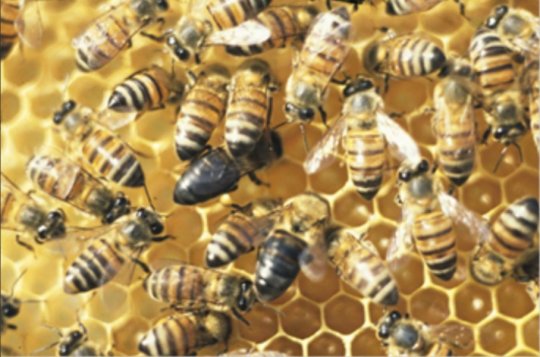[ad_1]
Among the social insects, bees have developed a strong and rich social network, where busy worker bees tend to the queen, who in turn, controls reproduction for the benefit of the hive.
But the South African Cape honey bee (Apis mellifera capensis) can flaunt these rules. In a process of genetic trickery called thelytoky syndrome, worker bee females ignore the queen’s orders and begin to reproduce on their own.
Scientists, in their own altruistic effort to protect the Cape honey bees from a recent devastating blight, transferred the Cape honey bees to a northeastern region — only to see the Cape bees wreak havoc among colonies of the neighboring honey bee subspecies A. m. scutellata.
The A. capensis bees turned from altruistic workers to the guests who would not leave — becoming social parasites that forage on their own into foreign colonies, reproducing an army of loyal workers, stealing all the honey, and eventually, dethroning the queen and taking over the host colony.
This type of behavior, despite making for bad neighbors, makes a lot of evolutionary sense. If the queen is lost, then the thelytoky syndrome at one point must have first kicked in as a life raft to save the colony. But if this is the case, why hasn’t it become a more widespread phenomenon for other bee species?
Recently, scientists have combed through bee genomes to narrow down the genetics behind thelytoky, and linked these to candidate genes in the past few years — but to date, the master genetic switch has not been found.
Now, for the first time, a group led by Denise Aumer and Eckart Stolle, working in the lab of Robin Moritz at the Martin-Luther-Universität Halle-Wittenberg’s Institute of Biology, have finally found the root cause responsible for thelytoky. The findings were published in the advanced online edition of Molecular Biology and Evolution.
“Uncovering the genetic architecture underlying thelytoky is a big step towards understanding this mode of reproduction, not only in the Cape honeybee, but also in other insect species in general (e.g. many invasive ants reproduce in a very similar fashion),” said Stolle. “After having worked on the topic for so many years with so much efforts by our colleagues and us to add pieces to the puzzle and also with the one or other dead end, it is a huge accomplishment for us to have come to this point.”
By comparing the genomes of Cape honeybees which produce diploid female offspring (thelytoky) with those producing haploid male offspring (arrhenotoky, i.e. the expected mode of reproduction), they identified a candidate gene located on chromosome one, LOC409096, and proposed to call it Thelytoky (Th), as the major regulator of the selfish worker bee reproduction. Thelytoky encodes a receptor protein with a transmembrane helix and a signal peptide at the extracellular N-terminus, indicating that it is linked to a secretory pathway.
Specifically, a single mutational substitution in exon 7 of Thelytoky causes a change from the polar amino acid threonine to the non-polar amino acid isoleucine in the protein sequence, leading to substantial structural modifications and likely functional consequences. In addition, they confirmed their genetic data by showing that RNA levels of Thelytoky were elevated only in the selfish bees. They also performed DNA sequencing of another honey bee population and found the same exact mutation amongst the socially parasitic lineage of the Cape honey bee, but not among workers of other honey bee subspecies.
From the study of the genetics, they determined that Cape bee selfishness exhibits a dominant inheritance pattern, which means that only one mutation that needs to be passed down to perform the selfish genetic switch.
But the genetics are a bit more complicated because it turns out that the selfish gene still needs its altruistic partner (known as the social, or arrhenotoky form of the gene).
“The genetic control of the thelytoky syndrome is regulated by a more complex genetic mechanism than previously assumed,” said Aumer. “The thelytoky allele (Th) is not recessive, i.e., needing two copies of the mutated gene, but rather a dominant allele. This dominant mutation expresses the phenotype (thelytoky) when one copy of the gene is the mutated variant, and the other copy is the one variant typical for the Cape honey bee.”
“But at the same time, it appears that having two copies of the mutated variant is detrimental, perhaps even lethal, while having two copies of the “regular” Cape bee variant of this genes makes them reproduce normally. Any other combination of the mutated variant with another subspecies’ variant would be non-matching alleles and would result in either non-functional or fertile normally reproducing (arrhenotokous) phenotypes. Therefore, the Cape bee typical Th variant seems to complement the mutated Th variant in a way that the offspring is fertile and expresses the unique set of phenotypes referred to as thelytoky syndrome.”
Because only one gene can get passed on during reproduction, the genetics not only explain why breeders, for the past 150 years, have been mostly unsuccessful with producing thelytokous workers from mating the Cape bees with others, but also why the thelytoky behavior hasn’t spread into other bee populations.
Genetically, it turns out you still need a little altruism to be truly selfish. When only one is passed on from interbreeding, the effect is lost without its partner gene.
“On a broader level, the identified genetic architecture of thelytoky in honey bees may serve as a model for other eusocial species with similar thelytokous reproduction, in particular for novel ant model systems, such as Platythyrea punctata and the clonal raider ant Ooceraea biroi,” wrote the authors in the Molecular Biology and Evolution publication.
And just like the striking case of malaria and hemoglobin genes in humans, the study shows how just a single change in the DNA can have such a dramatic effect on a species, or in this case, changing the behavior of a bee from a helper to a mercenary.
[ad_2]















